Intel’s Sandy Bridge i7-2820QM: Upheaval in the Mobile Landscape
by Jarred Walton on January 3, 2011 12:00 AM EST- Posted in
- Laptops
- Intel
- Sandy Bridge
- Compal
Extended Compatibility and Performance Results – Medium Detail
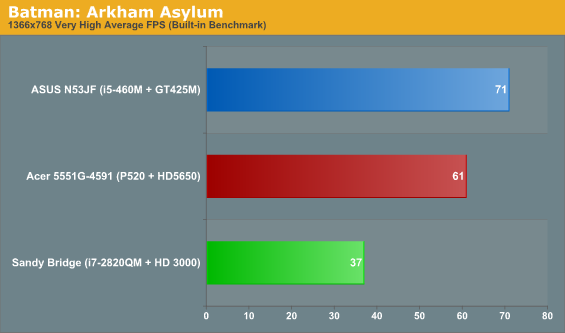
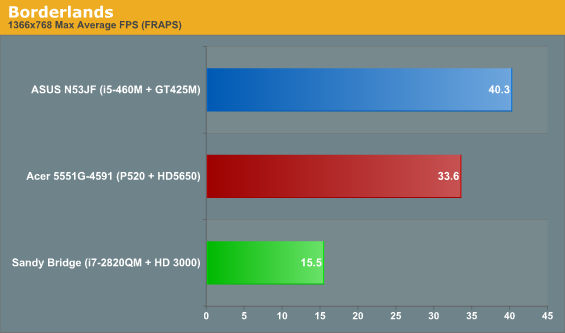
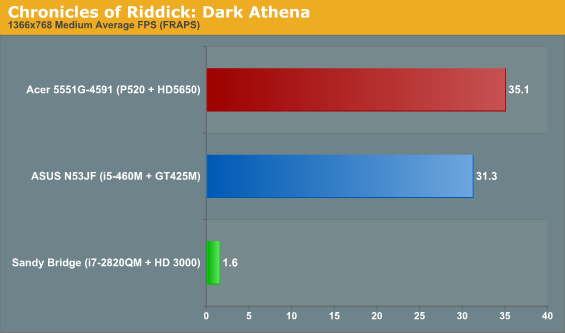
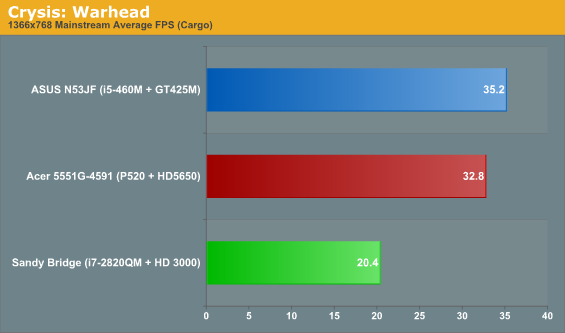
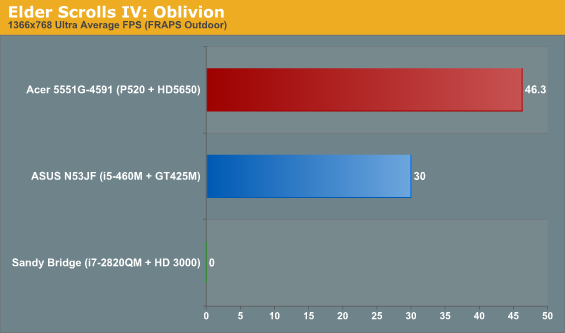
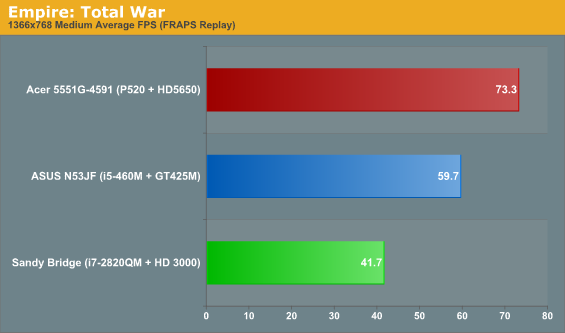
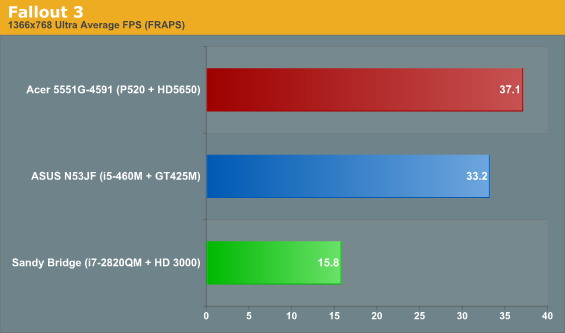
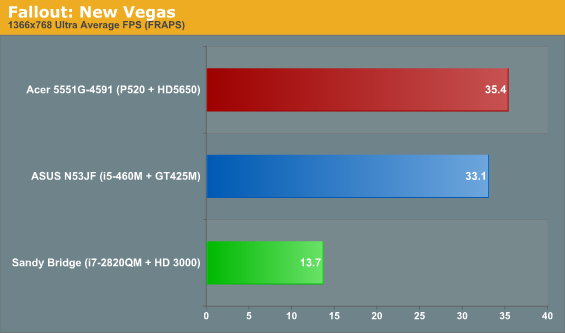
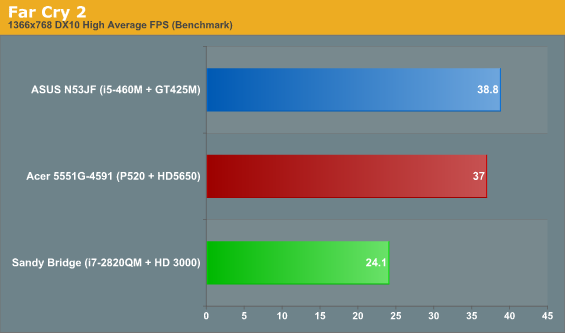
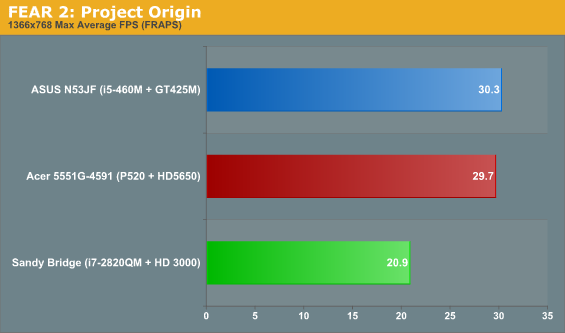
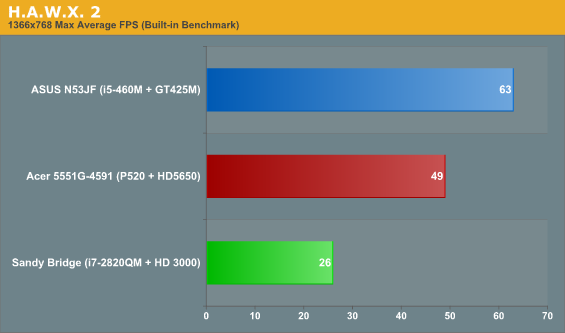
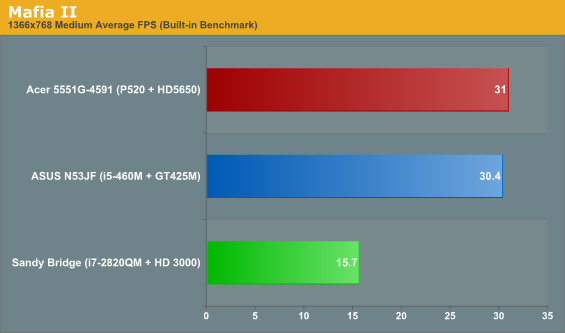

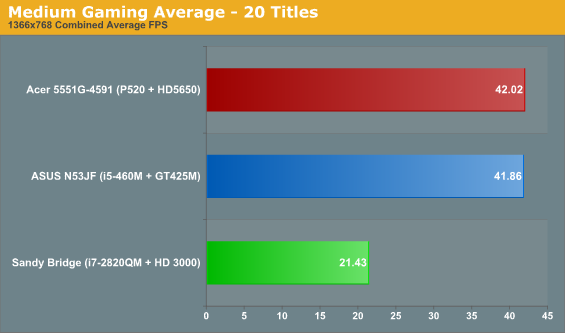
Bumping quality settings up to Medium puts the screws to the HD 3000, dropping nearly every test game below 30FPS. Besides Mass Effect 2 and STALKER (which we mentioned on the previous page), only Empire: Total War breaks the 30FPS mark, and it’s not even a clear victory there. Yes, Intel can run Medium detail at 42FPS, but the game prevents us from selecting the “High” defaults, which is where we would have preferred to test. (This is possibly another case of blacklisting, although not as severe as Fallout 3.)
At our Medium settings, the discrete GPUs easily pull away from Sandy Bridge, with both the Acer 5551G and ASUS N53JF nearly doubling (95-96% faster on average) the HD 3000. Rendering quality also gets worse in HAWX 2, with the entire skybox missing once detail levels are increase, so you get a black sky. (It’s still better than the horribly corrupted rendering that Arrandale’s IGP managed at lower settings.)
Ultimately, Sandy Bridge’s IGP is far more capable than many would have expected. Sure, it doesn’t even try to support DX11 or OpenCL, but at least for gaming DX11 is typically too much for even midrange GPUs. Intel uses 114 million transistors in Sandy Bridge on the graphics, which is quite small considering transistor counts on other GPUs. The HD 5470 for example—a chip that is frequently surpassed by HD 3000—has an estimated count of 242 million transistors.
This is where Intel’s manufacturing prowess comes into play, as SNB uses a refined 32nm process that allows Intel to push clock speeds far higher than other competing offerings. What’s more, late 2011 should bring the follow-up Ivy Bridge processor, which shrinks the process even further to 22nm. At that node, Intel could potentially double the number of EUs (Execution Units) and further increase clocks. If Intel puts the requisite effort into improving driver compatibility and adds DX11 support, and if rumors of high-bandwidth stacked memory prove true, next year we could see integrated graphics reach the point where they match HD 5650/GT 425M, effectively killing off anything less than the upper-midrange and lower-high-end discrete GPUs.










66 Comments
View All Comments
seamusmc - Friday, January 7, 2011 - link
I'm a notebook noob, up till now I've avoided them as much as I could. I have evaluated them over the years and have a pretty good dell precision 4500 at work, however, I had to build a desktop because the laptop, as provided, just doesn't cut it. With a SSD and 8 GB of ram it would probably suffice but I run a lot of Virtual Machines for testing.Anyhoo, enough of my background: I am very interested in the Sandy Bridge line specifically the retail chips, 2720 and 2820.
However all I'm seeing announced from the OEM's are 2630 based solutions. Are the OEM's going to have an option to upgrade to the retail chips? Are the 2720 and 2820 going to be available any time soon or is it just the 2630 that will have broad availability?
Who will have the retail chips available?
GullLars - Saturday, January 8, 2011 - link
This review unit came with an Intel SSD, which probably made a huge impact on general usage, but can we expect SSD boot drives for most Sandy Bridge laptops?If i were Intel, i'd make a branding program where Sandy + Intel SSD (310, G2, or newer) gave a fancy sticker for marketers to drool over, guaranteeing smooth and snappy operation without hiccups from spinning platter IOs.
IntoGraphics - Monday, January 17, 2011 - link
"We might get some of the above in OEM systems sent for review, and if so it will be interesting to see how much of an impact the trimmed clock speeds have on overall performance."Looking forward for this to happen. Very important to know for me. Because I will be using Adobe Illustrator CS4, Cinema 4D R12 Prime, and Unity 3D.
I hope that the performance impact between an i7-2720QM and a i7-2820QM, is as minimal as it was between the i7-740QM and i7-840QM.
It's going to be a toss up between the SB Dell XPS 17 and the SB HP Envy 17 for me, combined with a Dell or HP 30" monitor. Just too bad that both notebooks will not offer 1920x1200 resolution.
psiboy - Wednesday, January 19, 2011 - link
Your gaming benchmark is a joke! Anyone who has a radeon 5650m in there laptop isn't going to set game setting to "Ultra Low" a good mid range setting would have been more realistic and probably playable... but the Intel HD graphics on Sandy Bridge would not have looked so good then.... "Lies, damned lies and statistics!" all manipulated so the uneducated are taken in to think they can game on Intel IGP's....BTW: Dirt 2 looks like crap on Ultra Low...
katleo123 - Tuesday, February 1, 2011 - link
It works on new motherboards based on Intel’s forthcoming 6-series chipsetsVisit http://www.techreign.com/2010/12/intels-sandy-brid...
welcomesorrow - Friday, June 10, 2011 - link
Hi,I would mostly appreciate your suggestions regarding the bottleneck of overclocked QSV.
I have Core i5-2400s on Intel's DH67BL (H67) mother and have been using Media Espresso 6.5 to transcode ts files (MPEG-2) into H.264 by QSV. DH67BL allows me to overclock the graphics core from its default 1.1GHz to 2GHz. I observe linear shortening of transcoding time from 43 seconds/GB (1.1GHz) to 35 seconds/GB (1.6GHz), but beyond that there is no further improvement. Thus, it is expected to be transcoding in 30 seconds/GB at 2GHz but in reality it takes 35 seconds/GB.
QSV encoding in Media Espresso 6.5 is already ultrafast, and first I thought it might be hitting the I/O bandwidth of HDD, but it was not the case because SSD or even RAMDISK did not improve the situation.
Any idea about what is becoming the bottleneck of overclocked QSV? My guess is that it has something to do with either Sandy Bridge's internal hardware (such as data transfer) or Media Espresso's logic or both.